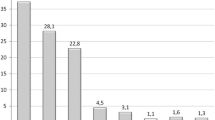Abstract
Background
Overweight and obesity lead to serious health consequences, so that many strategies were recommended for preventing or curing this emerging problem. Treatments are various: diet, physical activity, psychotherapy, drugs, and bariatric surgery. Moreover, during these years, the use of intragastric balloon (BIB) to treat obesity increased rapidly, aimed to (1) reduce bariatric surgical risks; (2) reduce general surgical risks; (3) lead to a significant reduction in the prevalence of cardiovascular diseases, diabetes, musculoskeletal disorders and some cancers. Recently, a new device inflated with air to reduce weight has been developed since 2004 (Heliosphere BAG).
Methods
Between March 2006 and September 2006, in our unit, intragastric air-filled balloon insertion was performed under general anesthesia and endoscopic control. The balloons were removed after 6 months. We evaluated efficacy, tolerance, and safety of this technique. Seventeen patients (eight men, nine women), with a mean age of 43 ± 10 years (range 18–65), mean basal BMI of 46 ± 8 (range 35–58) were included, after providing informed consent. Weight and BMI loss were evaluated in all patients.
Results
BMI decreased 4 ± 3 (range +0.33/−11), weight loss was 11 ± 9 kg (range +1/−29.5; 8.5%). 14/17 patients maintain a BMI > 35 at the time of balloon removal. The difference between initial weight and BMI was statistically significant (p = 0.02 for weight and p < 0.01 for BMI, T Student test). Tolerance was very good, limited only to some dyspeptic symptoms during the first 3 days after insertion. One asymptomatic gastric ulcer was seen at the removal of balloon. Only one severe adverse effect was registered at the time of insertion (acute coronary syndrome in patient with chronic coronary disease). No serious technical problems were noted at balloon insertion. Balloon removal was more difficult and successful in 15/17 cases (one distal migration and one patient led to surgery because of balloon fragmentation).
Conclusion
Intragastric air-filled balloon showed a good profile of efficacy and tolerance. Weight loss appeared to be equivalent to other type of balloons. On the other hand, technical problems (especially at the time of removal) probably linked to the device’s material, set a low safety profile.


Similar content being viewed by others
References
Melissas J, Christodoulakis M, Spyridakis M, et al. Disorders associated with clinically severe obesity: significant improvement after surgical weight reduction. South Med J. 1998;91:1143–8.
WHO. Obesity: preventing and managing the global epidemic. Report of a WHO consultation on obesity. Geneva: WHO; 1998.
Mion F, Napoléon B, Roman S, et al. Effects of intragastric balloon on gastric emptying and plasma ghrelin levels in non-morbid obese patients. Obes Surg. 2005;15:510–6.
Melissas J, Mouzas J, Filis D, et al. The intragastric balloon—smoothing the path to bariatric surgery. Obes Surg. 2006;16:897–902.
Genco A, Bruni T, Doldi SB, et al. BioEnterics intragastric balloon: the Italian experience with 2,515 patients. Obes Surg. 2005;15:1161–4.
Genco A, Cipriano M, Bacci V, et al. BioEnterics intragastric balloon (BIB): a short-term, double-blind, randomised, controlled, crossover study on weight reduction in morbidly obese patients. Int J Obes (Lond). 2006;30:129–33.
Roman S, Napoleon B, Mion F, et al. Intragastric balloon for “non morbid” obesity: a retrospective evaluation of tolerance and efficacy. Obes Surg. 2004;14:539–44.
Al-Momen A, EL-Mogy I. Intragastric balloon for obesity: a retrospective evaluation of tolerance and efficacy. Obes Surg. 2005;15:101–5.
Forestieri P, De Palma GD, Formato A, et al. Heliosphere® bag in the treatment of severe obesity: preliminary experience. Obes Surg. 16:635–7.
Mion F, Gincul R, Romane S, et al. Tolerance and efficacy of an air-filled balloon in non-morbidly obese patients: results of a prospective multicenter study. Obes Surg. 2007;17:764–9.
Boyle TM, Agus SG, Bauer JJ. Small intestinal obstruction secondary to obturation by a Garren gastric bubble. Am J Gastroenterol. 1987;82:51–3.
Ulicny KS Jr, Goldberg SJ, Harper WJ, et al. Surgical complications of the Garren–Edwards gastric bubble. Surg Gynecol Obstet. 1988;166:535–40.
Schapiro M, Benjamin S, Blackburn G, et al. Obesity and the gastric balloon: a comprehensive workshop. Florida: Tarpon Springs; 1987. March 19–21.
Author information
Authors and Affiliations
Corresponding author
Rights and permissions
About this article
Cite this article
Trande, P., Mussetto, A., Mirante, V.G. et al. Efficacy, Tolerance and Safety of New Intragastric Air-Filled Balloon (Heliosphere BAG) for Obesity: the Experience of 17 Cases. OBES SURG 20, 1227–1230 (2010). https://doi.org/10.1007/s11695-008-9786-2
Received:
Accepted:
Published:
Issue Date:
DOI: https://doi.org/10.1007/s11695-008-9786-2




